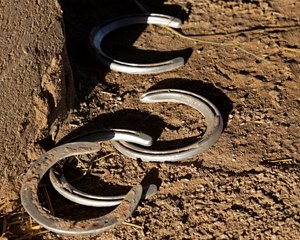HISA Amends Hind Shoe Rules After Meeting with Horsemen


The Horseracing Integrity and Safety Authority announced July 29 that enforcement of certain aspects of its horseshoe rules would not be enforced when the rule is enacted Aug. 1. Specifically, enforcement shall not apply to horses racing on dirt surfaces that are shod on the hindlimbs with traction devices of either a full outer rim shoe or a toe grab up to four millimeters in height.
The rule change followed a July 19 meeting in Saratoga Springs, N.Y., between the HISA Safety Committee and the Thoroughbred Horsemen's Association board of directors, and representatives of the Kentucky Thoroughbred Association, Thoroughbred Owners and Breeders Association, and Thoroughbred Owners of California. Among the short-term and long-term issues discussed was the shoe rule, which has generated significant concern among horsemen for its potential to negatively affect the safety and welfare of horses, according to THA.
HISA said its committee members were made aware of "widespread concerns that the traction provided by full outer rim shoes and toe grabs for the hindlimbs is essential for the safety of horses in certain circumstances," including breaking from the gate and during impacted track conditions.
According to THA, this meeting was followed by another July 27 meeting involving Safety Committee members and trainers John Kimmel, Ian McKinlay, Graham Motion, and Linda Gaudet, owner and New York THA president Joe Appelbaum, national THA chairman and CEO Alan Foreman, and New York equine medical director Dr. Scott Palmer.
"The dialogue was invaluable, as it gave the Safety Committee the opportunity to explain its rationale for the rule and the THA group the opportunity to respond," said a THA statement. "We are pleased that this morning, HISA has announced that it is implementing the change we recommended that allows horses racing on dirt to have certain hindlimb traction devices. We are particularly appreciative of the contributions of John Kimmel, Scott Palmer, and Ian McKinlay for providing critical evidence-based support for the need to change the rule."
HISA added in its Friday announcement that "after full consideration of the matter, the committee strongly recommended the use of full outer rim shoes for hindlimb traction because these shoes provide traction while enabling the hoof to land flatly on the track surface, whereas toe grabs accentuate stressors on bone and soft tissues, such as tendons and ligaments, which contributes to injury."
While the THA said it continues to see no horsemen's representative on the Safety Committee as a "missed opportunity," the organization said it will "continue to vigorously advocate for the best interests of the safety and welfare of the horse and the best interests of our horsemen. We continue to engage with HISA as the best way to serve our membership, and the industry at large, and this decision underscores their willingness to engage with us and make changes as necessary."
All other provisions of HISA Rule 2276 shall remain in effect, the organization announced. Rule 2276 largely prohibits horseshoe traction devices and outlines the conditions when such types of shoes are allowed. The full Friday announcement can be read online.
